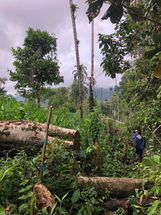
ENVIRONMENTAL
IMPACT
DEFORESTATION-THE NEED FOR ALTERNATIVES
Vulnerable communities in the Amazon Rainforest and other rural areas see no other alternatives but to extract resources to make a living.
Logging, extraction of oil and minerals, cattle ranching, and the use of monoculture crops are widespread ways to make a living in Ecuador and other countries of the Global South.
A large amount of deforested patches are visible from satellite
Napo , Ecuador
MONOCULTURE CROPS
LOGGING
PASTURES
OIL RIGS
MONOCULTURE FORESTS
RESTORATION, CONSERVATION & REGENERATIVE AGRICULTURE
By joining Humans for Abundance, our restorers find an alternative and more sustainable way to make a living.
The eco-actions they perform restore their soils and bring back biodiversity to their lands.
Restoring soils and forests sinks carbon from the atmosphere into the ground.
Conserving primary forests prevents more carbon from being released into the atmosphere.
Our restorers do important work for all of us under these categories:
ECOLOGICAL RESTORATION
Regenerating a degraded habitat back to its former trajectory is possible. It only needs the the right resources and the commitment of hard-working locals.

Before being a biodiverse forest, Omar Tello's land had pastures for cows.

Today, it houses a great variety of plants and animals. In return, the restored forest provides seeds for further restoration in other lands.

The seedlings go to local communities that are joining the restoration movement.
.jpeg)
7500+
trees planted by our restorers during our pilot project
(2020 - 2021)
200+
hectares under restoration process during our pilot project
(2020 - 2021)
CONSERVATION OF KEY AREAS
The reserves our restorers protect contain some of the most diverse and most scientifically important forests in the world.
Some of these areas have more biodiversity than many entire countries and more unique locally-endemic plant species than in all of the world-famous Galápagos Islands.


Andean Danta or Danta de páramo (Tapirus pinchaque) - photo taken by camera trap set up by Juan Pablo Reyes
Their habitats house many endangered species of Andean mammals and birds like the spectacled bear, the black and chestnut eagle or the mountain tapirs.
These species are key for the health of these forests and the local families need resources to keep them protected from hunters, loggers, illegal orchid collectors, and cow ranchers who invade these reserves to plant grass.





Many frog species found in Omar Tello's forest - photos taken by Omar Tello
Hunters travel long distances to kill woolly monkeys in this area as they provide a lot of meat.
These forests have been so well protected that they are no longer afraid of humans. This is why it is possible to take such close-up pictures. Their numbers are increasing!


Woolly monkeys photographed by Santiago and Fausto Recalde
5000+
hectares of Andean and Amazon forests protected since 1980
SCIENCE-BASED
ECO-ACTIONS
The eco-actions our restorers offer promote these benefits for the environment
RECOVERY OF ENDANGERED AND ENDEMIC PLANTS
We plant tree species that exist only within the area and are endangered according to the International Union for Conservation of Nature (IUCN) and the Red Book of Endemic Plants of Ecuador. With the planting of native and endangered species we are avoiding the disappearance of species in the forest and keeping the balance in the ecosystem.
SUSTAINING ENDANGERED AND ENDEMIC WILD ANIMAL POPULATIONS
We seek to generate forest areas that are connected to each other or function as ecological corridors, so that animals can move between forested areas, have more available habitat and have greater genetic population variability. There are animals in this region that are critically endangered, such as the jaguar (Panthera onca) that have a life range of up to 309.7 km2, and if they do not have a large area of forest, it is highly probable that they will become locally extinct in the near future. Protecting their habitats is fundamental.
BUFFER AREA MAINTENANCE
We restore disturbed areas near national parks or ecological reserves, which help neutralize the effects of human intervention. In this way, we ensure the effectiveness of ecological protection within these parks or reserves that act as source areas for healthy and genetically diverse populations of flora and fauna.
PROTECTION OF CENTENNIAL TREES
We protect old trees or "mother trees". A 35-year-old tree can capture up to one ton of CO₂ per year. In addition, old trees, besides being the refuge of a large number of species of flora and fauna, have an important role in the ecosystem. They help maintain ecological processes within the forest, such as hydrological regimes and nutrient cycles. By keeping these trees alive we are allowing the correct functioning of the ecological processes of the forest.
CARBON STORAGE AND SEQUESTRATION
By planting trees we contribute to a greater capacity to absorb excess CO₂ emitted into the atmosphere. This is vital to reduce greenhouse gas emissions that cause global warming. The greater the number of large trees on the planet, the more carbon will be captured and contained. In addition, by protecting remaining areas of forest, we are recovering biomass, thereby increasing the rate of carbon sequestration, and preventing the release of carbon as a result of logging.
PROTECTION OF NEW SPECIES POTENTIALLY BENEFICIAL TO HUMANITY
Many regions of Ecuador are characterized by their endemism, that is, there are species that only exist in these parts of the world, and have not yet been described by science. The plants of the tropical forests are rich in secondary metabolites, such as alkaloids, which have proven to have a high medicinal value. By conserving the native forests of this region, we are saving species that can be of potential use to humans as a medicinal source.
CREATE MORE POSITIVE IMPACT!
Do more than recycle and reuse.
BE THE SOURCE OF ABUNDANCE
We take care of the rest.








.jpeg)
